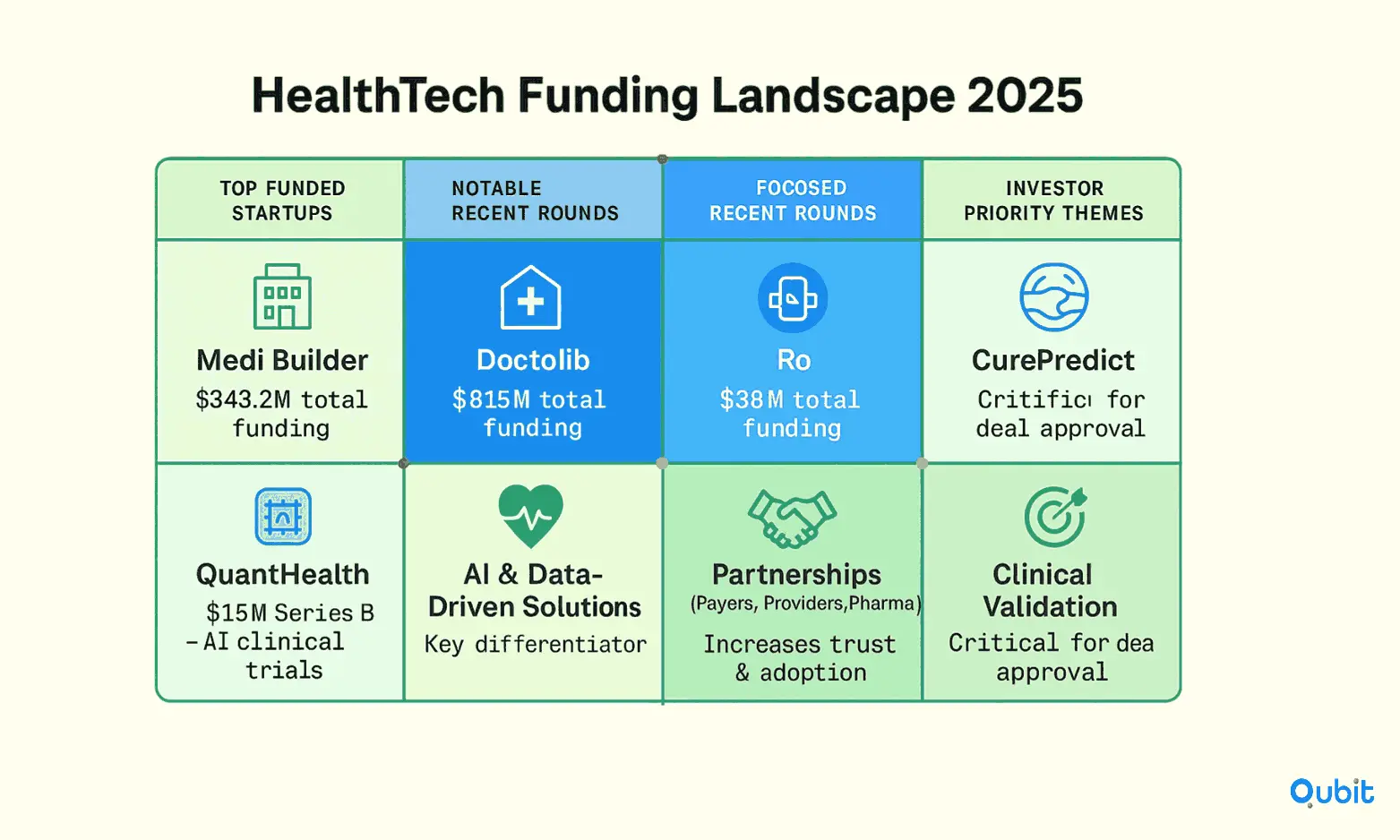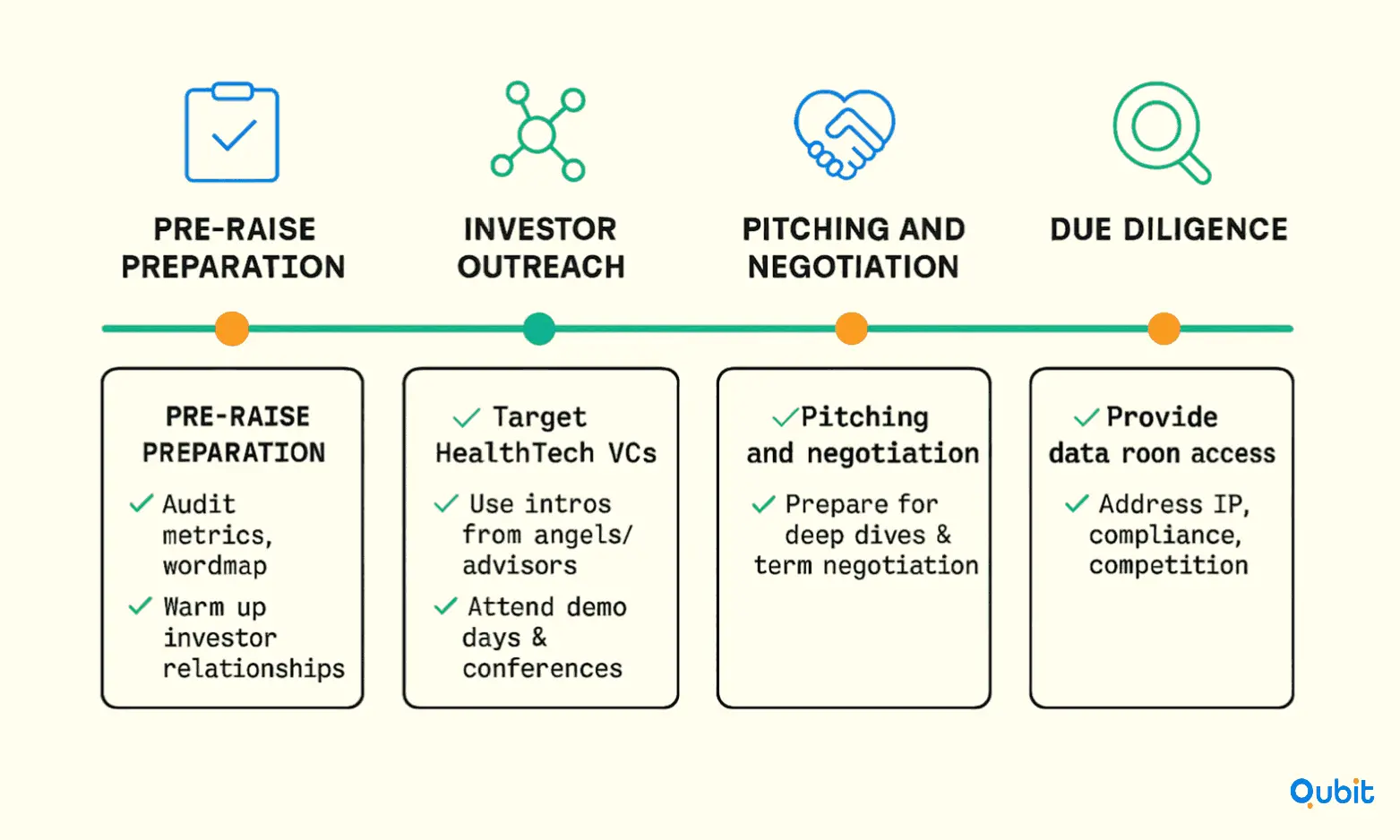Securing Series A and B funding is a defining moment for HealthTech startups. These rounds are not just about raising capital, they’re about proving your business model, scaling operations, and attracting the right partners to take your vision global. In 2025, with digital health investment rebounding and investors sharpening their focus on clinical impact, regulatory readiness, and scalable tech, founders need a clear strategy to stand out and succeed.
This article unpacks the current funding landscape, what investors expect at each stage, and actionable strategies for navigating Series A and B rounds in HealthTech.
Understanding Series A & B: What’s at Stake?
Series A is typically the first major institutional round, where startups move from validation to scaling. Series B is about accelerating growth, expanding into new markets, and deepening product capabilities. Both rounds require strong traction, a proven business model, and a compelling vision for the future of healthcare.
Typical funding sizes (2025):
- Series A: $5M–$20M
- Series B: $15M–$50M+
(Recent deals: QuantHealth $15M Series A, Carrum Health $45M Series B, CureBay undisclosed Series B leading Indian growth)

Despite global economic headwinds, HealthTech remains a magnet for capital. In the first half of 2025, top startups like Medi Builder ($343.2M total funding), Doctolib ($815M), and Ro ($38M) have shown that investors are backing platforms with real-world impact and scalable models. Series A and B rounds are increasingly competitive, with investors prioritizing:
- Clinical validation and regulatory progress
- AI and data-driven solutions
- Partnerships with payers, providers, and pharma
- Clear go-to-market and commercialization strategies
Notable recent rounds:
- QuantHealth: $15M Series A for AI-powered clinical trial design
- Carrum Health: $45M Series B to scale bundled care for employers
- CarePredict: $29M Series A-3 for AI-enabled senior care
- CureBay: Led Indian Series B with a focus on digital health access.
Securing funding in healthcare isn’t just about a slick pitch deck. Breaking down healthcare fundraising into manageable steps, how to secure funding for healthcare startups: a step-by-step guide lays out exactly what to do at each stage of the process.
What Investors Expect at Series A
1. Demonstrated Product-Market Fit
Investors want evidence that your product solves a real healthcare problem, with paying customers, high user engagement, and positive clinical outcomes. Case studies, published data, and strong retention rates are key.
2. Clinical and Regulatory Traction
- Clinical validation: Peer-reviewed studies, pilot results, or real-world evidence.
- Regulatory progress: FDA/CE clearances, HIPAA compliance, or a clear regulatory roadmap.
3. Scalable Technology
- Cloud-based, interoperable, and secure platforms.
- AI/ML capabilities that drive value and differentiation.
4. Go-to-Market Strategy
- Defined sales channels (B2B, B2C, enterprise, payer partnerships).
- Early revenue and a repeatable sales process.
- Strategic partnerships with health systems, payers, or pharma.
5. Strong Team
A founding team with healthcare, tech, and business expertise. Investors also look for advisors with clinical or regulatory backgrounds.
What Investors Expect at Series B
1. Proven Revenue Model
- Consistent, growing revenue streams (often $3M–$10M+ ARR).
- High customer retention and expansion within accounts.
2. Market Expansion
- Plans to enter new markets or verticals (e.g., new geographies, payer segments, or care settings).
- Evidence of scalable operations and infrastructure.
3. Product Depth and Differentiation
- Expanded product offerings or deeper integration with existing healthcare workflows.
- Defensible IP, proprietary data, or exclusive partnerships.
4. Operational Excellence
- Robust financial controls, compliance, and reporting.
- Ability to recruit and retain top talent as the company scales.
5. Clear Path to Profitability or Exit
- Defined milestones for future rounds, acquisition, or IPO.
- Demonstrated interest from strategic partners or acquirers.
Key Funding Strategies for Series A & B
1. Build Early Relationships with Investors
Start networking with Series A/B investors well before you need capital. Attend industry events, join accelerator demo days, and leverage introductions from angels or seed investors. Investors like Sequoia, Greylock, and specialized HealthTech funds are active in 2025.
2. Leverage Strategic Partnerships
Partnerships with hospitals, payers, pharma, or tech giants (like Oracle Health or AWS) can provide validation, pilot opportunities, and even co-investment. These relationships often accelerate due diligence and open doors to new customers.
3. Showcase Clinical and Economic Impact
Quantify your impact, reduced hospitalizations, improved outcomes, or cost savings. For example, CarePredict’s AI reduced hospitalizations by 39% and falls by 69%, helping secure their $29M round.
4. Strengthen Regulatory and Compliance Readiness
Demonstrate regulatory progress and a clear plan for ongoing compliance. Investors want to see that you can navigate complex healthcare rules and scale safely.
5. Optimize Your Data Story
Investors want to see robust data on user engagement, clinical outcomes, and ROI for customers. Use dashboards, case studies, and third-party validation to make your metrics stand out.
6. Plan Your Use of Funds
Be specific about how Series A/B capital will drive growth—product development, hiring, market expansion, or regulatory milestones. Tie funding to clear, measurable objectives.
7. Prepare for Rigorous Due Diligence
Expect deep dives into your tech stack, clinical data, financials, and compliance. Have documentation ready and be transparent about risks and mitigation plans.
The Series A & B Process: Step-by-Step

1. Pre-Raise Preparation
- Audit your metrics, regulatory status, and product roadmap.
- Identify target investors and warm up relationships.
- Refine your pitch deck, focus on traction, impact, and scalability.
2. Investor Outreach
- Use a targeted list of HealthTech VCs and growth investors.
- Leverage introductions from angels, advisors, or accelerators.
- Attend industry conferences and demo days.
3. Pitching and Negotiation
- Highlight your unique value proposition, clinical data, and go-to-market strategy.
- Be ready for multiple meetings, technical deep dives, and negotiation on terms.
4. Due Diligence
- Provide access to data rooms with clinical, financial, and operational details.
- Address questions on IP, compliance, and competitive landscape.
5. Closing and Post-Investment
- Finalize legal documents, board structure, and reporting requirements.
- Set up regular investor updates and leverage their networks for growth.
Real-World Examples: Series A & B in Action
- QuantHealth ($15M Series A): AI-powered platform for clinical trial simulation, backed by Bertelsmann Investments and Pitango HealthTech. Funding used for commercial expansion and new product development.
- Carrum Health ($45M Series B): Bundled care platform for employers, funded by Omers Growth Equity and Tiger Global. Focused on scaling oncology and surgical care offerings.
- CarePredict ($29M Series A-3): Senior care AI platform, backed by SV Health Investors and Aspire Healthtech. Funding accelerates adoption and product innovation.
- CureBay (Series B): Leading Indian digital health platform, using Series B to expand access and optimize technology.
Common Mistakes to Avoid
- Weak clinical validation: Investors want hard evidence, not just pilot anecdotes.
- Unclear regulatory plan: Failing to address compliance can kill deals.
- Overly broad focus: Trying to serve too many markets or use cases dilutes your story.
- Underestimating capital needs: Be realistic about the resources required for growth.
- Ignoring operational risks: Investors expect a plan for scaling people, processes, and compliance.
Global Trends: HealthTech Series A & B in 2025
- AI and Data Science Dominate: Startups like QuantHealth and Basys.ai are raising capital for AI-driven solutions in clinical trials and payer automation.
- International Expansion: Series B rounds often fuel entry into new geographies, as seen with platforms like Sami in Brazil and CureBay in India.
- Strategic Acquisitions: Larger HealthTech players are acquiring Series B startups to accelerate innovation and expand service lines.
- Government and Corporate Funding: Startups are tapping into government-backed funds and industry partnerships to complement VC capital.
How to Stand Out: Tips from Top Founders
- Focus on Clinical Outcomes: Publish your results and seek third-party validation.
- Build a Diverse Team: Investors value teams with clinical, technical, and commercial expertise.
- Invest in Customer Success: High retention and expansion rates signal product-market fit.
- Stay Agile: Be ready to pivot based on feedback from customers and investors.
- Leverage Thought Leadership: Share insights at industry events and in publications to build credibility.
Conclusion
As the global HealthTech market continues to evolve, founders who proactively address investor expectations and build sustainable, evidence-driven businesses will be best positioned for long-term success. Whether you’re preparing for your first institutional round or planning a major expansion, a clear funding strategy and the right partners can make all the difference.
Qubit Capital supports HealthTech founders through every stage of Series A and B fundraising. From refining your pitch and connecting with the right investors to navigating due diligence and scaling operations, our team brings deep sector expertise and a global network to help you succeed. Build momentum with our fundraising assistance for healthcare startups and schedule a discovery session.
Key Takeaways
- Series A and B funding are about scaling validated HealthTech solutions, not just raising capital.
- Investors expect clinical validation, regulatory readiness, scalable tech, and a clear go-to-market strategy.
- Strategic partnerships and strong data on outcomes and ROI are essential for standing out.
- Prepare for rigorous due diligence and be transparent about risks and plans for growth.
- Global trends in 2025 favor AI, international expansion, and government-corporate collaboration.
Frequently asked Questions
What’s the difference between Series A and B funding in HealthTech?
Series A is focused on scaling a validated product and proving the business model, while Series B is about accelerating growth, expanding markets, and deepening product capabilities.






